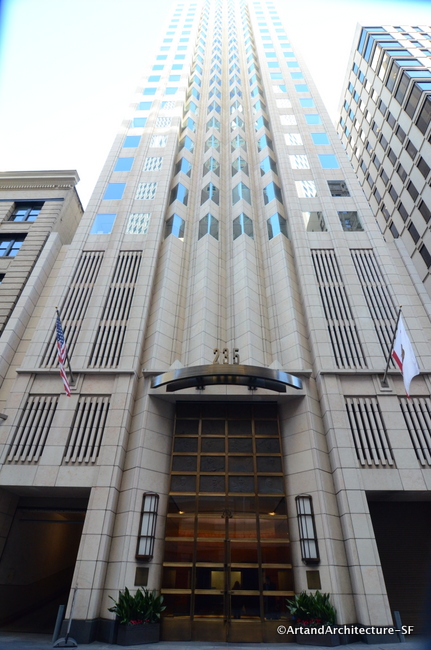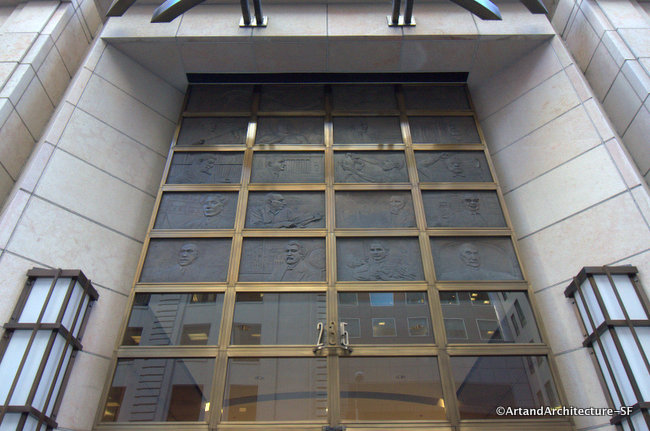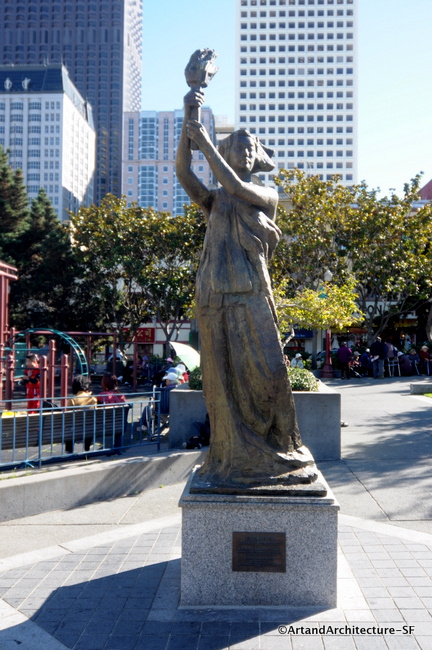235 Pine Street
Financial District
Called to Rise features individuals who have contributed significantly to the history of San Francisco. The figures include, Juan Bautista De Anza, Eadweard Muybridge, Makato Hagiwara, Phoebe Apperson Hearst, Chingwah Lee, Ishi, Alfred Louis Kroeber, Philip Burton, Amadeo Peter Giannini, Benjamin Franklin Norris, Timothy Pflueger, Douglas Tilden, Kurt Herbert Adler, Mary Ann Magnin, Harry Bridges, Robert Dollar, John C. Young, Howard Thurman, John Swett, Charlotte Amanda Blake Brown, Michael Maurice O’Shaughnessey.
Done in 1990 the sculptor was Thomas Marsh who has another piece here in San Francisco.
This bronze is part of the San Francisco 1% for Art Program.
The two bronze panels on each side of the door below the light explain the contributions of each person. Links are provided to art works representing the appropriate person or structure.
Juan Bautista de Anza (2735-c1788) Between 774 and 1776, De Anza brought settlers across vast deserts of the Spanish Southwest, without loss of life, into Alta California and the Bay of San Francisco.
Eadweard Muybridge (1830-1904) Muybridge took a series of photographs at the Stanford Farm in Palo Alto that led directly to the invention of the motion picture camera.
Makato Hagiwara (1854-1925) Hagiwara conceived of the idea of the “fortune cookie” and, together with his son established the Japanese Tea Garden in Golden Gate Park.
Phoebe Apperson Hearst (1842-1919) Mother of William Randlolph Hearst, the San Francisco newspaper tycoon, Mrs. Hearst devoted herself to the improvement and expansion of the University of California.
Chungwah Lee (1901-1980) Lee, a Hollywood actor for 40 years helped establish Boy Scout Troop 3, the first all-chinese troop in the United States and the Chinese Historical Society of America.
Ishi (c1860-1916) Alfred Louis Kroeber (1876-1960) Ishi, the last survivor of the Yahi people, worked in association with Kroeber to document the vanished language, customs, and values of his people.
Philip Burton (1926-1983) As author of the Golden Gate National Recreation Act, U.S. Congressman Burton helped preserve the headlands of Marin and northern edges of the San Francisco peninsula.
Amadeo Peter Giannini (1870-1949) Giannini established the Bank of Italy in North Beach, which he latr developed into the Bank of America, the premier bank of the United States.
Benjamin Franklin Norris (1870-1902) A writer of fiction, Norris helped establish the reputation of San Francisco as a romantic seaport city, alive with mystery and adventure.
Timothy Pflueger (1892-1946) Pflueger’s notable architectural achievements include the Pacific Stock Exchange Building, the Castro Theater, the Pacific Telephone Building on New Montgomery Street, and the San Francisco-Oakland Bay Bridge.
Douglas Tilden (1860-1935) Tilden is famous for his bronze sculptures; the Mechanics Monument on Market Street and the Baseball Player and Junipero Serra statues in Golden Gate Park.
Kurt Herbert Adler (1905-1988( Under Adler, the San Francisco Opera won fame for its bold re-staging of classics and its willingness to produce new or previously obscure works.
Mary Ann Magnin (1849-1943) Magnin, a pioneer business woman opened a notions and fine needlework shop which later grew into I. Magnin & Co., specializing in imported European clothing.
Harry Bridges (1901-1990) Bridges, a longshoreman on the docks of San Francisco played a major role in a coastwide strike spearheaded by the International Longshoreman’s Association
Robert Dollar (1844-1932) Dollar is considered a pioneer in the evolution of San Francisco as in important trade and shipping center for the Asia Pacific Basin in the early twentieth century.
John C. Young (1912-1987) An Engineer from Stanford University, Young devoted himself to the improvement of San Francisco’s Chinatown and helped found the annual Chinese New Years Parade.
Howard Thurman (1900-1981) As a preacher writer and social activist, Reverend Thurman helped establish the intellectual and moral foundations of the Civil Rights Movement in America.
John Swett (1830-1913) Devoted to teaching and developing the public schools of San Francisco Swett helped form Lowell High School and pioneered the education of children in preparation for college.
Charlotte Amanda Blake Brown (1846-1904) Dr. Brown, a specialist in the care of women and children helped found Children’s Hospital. She also played a major role in establishing nursing education in San Francisco.
Michael Maurice O’Shaughnessey (1864-1934) As city engineer O’Shaughnessey laid out the municipal railway streetcar system and is mainly noted for his contributions to the Hetch Hetchy water and power system.


